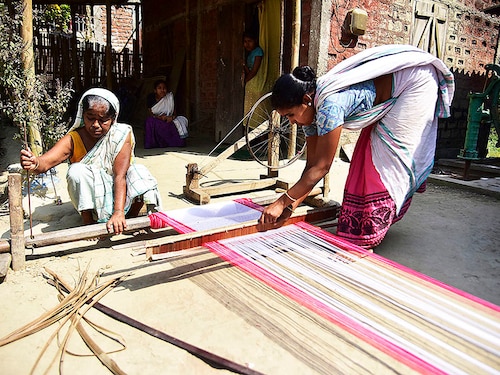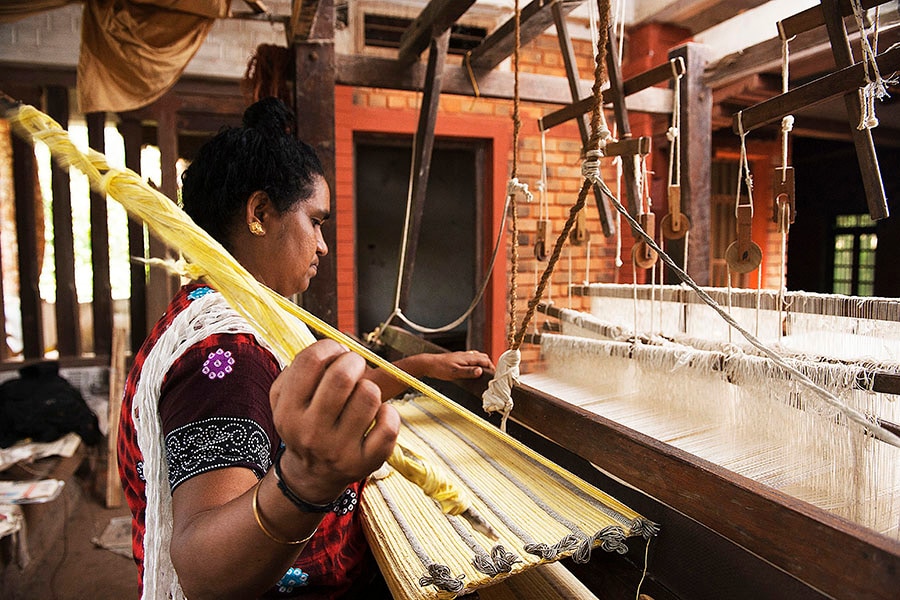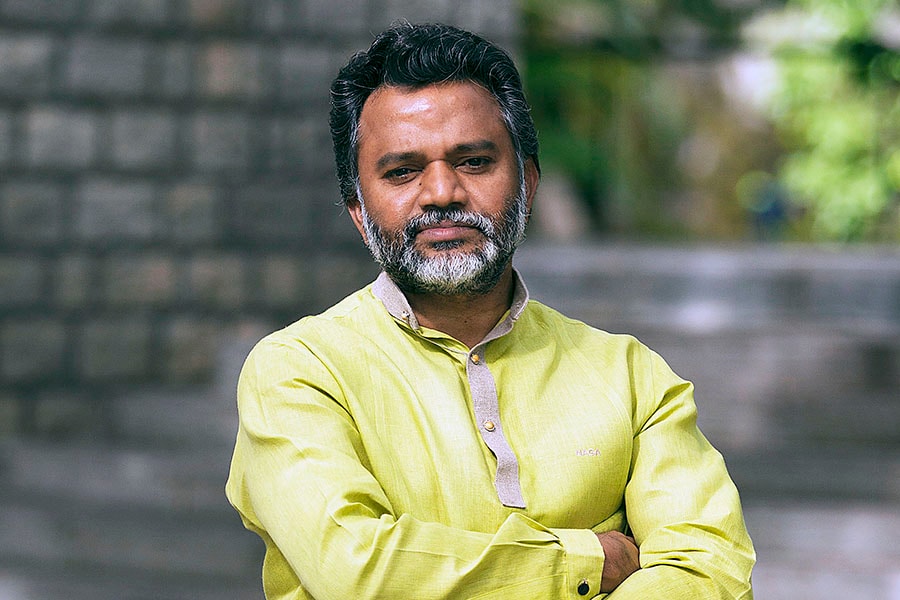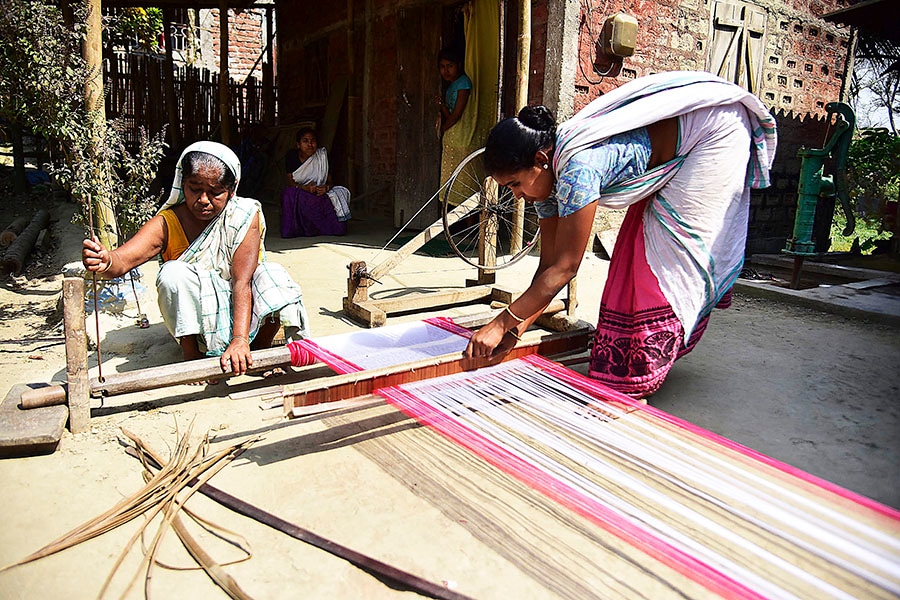Silence of the looms
The handloom sector has come to a complete standstill, and needs immediate and meaningful interventions to survive


 A handloom weaver of Balarama-puram near Thiruvanan- thapuram, Kerala
A handloom weaver of Balarama-puram near Thiruvanan- thapuram, Kerala
Image: Mexy Xavier
As Covid-19 continues its deadly spread, lockdowns and the resulting supply chain disruptions have significantly impacted the economy globally, especially the micro, small and medium enterprises. India has over 9 million weavers and artisans who are severely impacted due to a shutdown of sales and production activities, resulting in a loss of livelihoods.
Handlooms are an important part of India’s rich culture and tradition, and the sector is the second largest employment provider in the country, after agriculture. According to the 2019-20 National Census of Handloom Weavers, there are 31.44 lakh households engaged in weaving and allied activities, out of which 87 percent are in rural areas. Over 66 percent of weavers earn less than Rs 5,000 a month. The sector contributes significantly to women’s empowerment, with over 70 percent of all weavers and allied workers being women.
The handloom sector has a deep interdependence with agriculture, as its raw materials include cotton, and in many states we see weaver households where farming and weaving are practised together, especially in the Northeast. In a country that relies heavily on the rural economy for job creation, the importance of handlooms is well understood.
At gocoop.com, we connect weavers, artisans, cooperatives and clusters directly with buyers across the world. Recently, we reached out to our weavers in different clusters to understand how the pandemic has impacted their lives and work.
Ground Realities
Health and well-being: All the weavers we spoke to understand the importance of social distancing, using face masks and washing hands. They are stepping out of their homes only to buy groceries and essential items. Some are also making masks and distributing them to their friends and family. For sustenance, they are able to get groceries and other essential items, and some of them are being supported by the government’s scheme to provide free ration for three months.
“It is important to get the looms started again. For that, we need, on one side, raw materials and, on the other, orders... weavers need working capital on both sides.”
NAGARAJA PRAKASAM, partner, AcumenComplete stop in sales, production: The most significant impact of the lockdown has been the end of both sales and production activities. Most weavers and artisans hold huge inventories, which they had stocked up for festivals such as Holi, Ugadi and Vishu, as well as for exhibitions.
Very few weavers are able to continue production activities as they have limited raw material available, and cannot procure any because of the lockdown. This, along with uncertainty over demand in the near future, means most cooperatives and master weavers are unable to give production orders to other weavers. Most of the existing orders have either been put on hold or cancelled. With no work, weavers are unable to earn their weekly wages.
What is Required
Raw material sourcing: Weavers need support in sourcing raw materials to complete existing orders. If they can’t complete them on time, it will lead to order cancellations and further losses. The National Handloom Development Corporation and other government agencies can identify clusters with acute shortage of raw materials and take necessary action.
“We have ongoing orders [received before the lockdown] but are not sure when the buyers will pick them up. Payments take 3-4 months after the orders are picked up. In this crisis, we need some working capital to support ourselves and our weavers,” says Akunuri Cheralu, a weaver and president of the Shatranji Nawar Cooperative Society in Warangal, Telangana.
Working capital and micro-loans: Most master weavers and entrepreneurs need working capital loans to sustain their livelihoods, and lack access to bank credits at favourable terms. Small, interest-free micro-loans of Rs 10,000 to Rs 20,000 directly to weavers could help them procure raw materials and also in sustenance. Similarly, for small entrepreneurs, subsidised collateral-free loans of Rs 10 lakh to Rs 15 lakh could enable them to continue production, and also support weavers and artisans they work with.
“It is important to get the looms started again. For that, we need, on one side, raw materials and, on the other, orders weavers need working capital on both sides,” says Nagaraja Prakasam, partner at Acumen, a non-profit impact investment fund, and angel investor in social businesses. “Government organisations like Sidbi, Nabard and public banks could include crafts among priority sectors, provide a corpus to NBFCs and encourage them to provide loans to weavers. Banks can also device business correspondent models for weavers.”
Liquidating inventories: Master weavers and entrepreneurs are looking for wholesale or B2B buyers to liquidate their inventories. This will generate some cash flow to pay wages to weavers. The government can organise virtual buyer-seller meets and give a subsidy of 10 to 20 percent (directly to weavers) for retail and wholesale buyers, which will enable them to buy the stocks over the next two months. The government can also ask state and national handloom bodies to buy part of the inventories and make payments immediately.
The scenario post Covid-19 is difficult to comprehend at this point, but it is clear that demand patterns will change, the disposable income and purchasing power of the market will not be the same. “The immediate need would be to decipher and assess the product need and create products accordingly, rather than going on making what we did in the past,” says Shreya Bhattacharya, a designer with Baragaon Weaves. Women weave the traditional Assamese gamosa in Assam’s Nagaon district
Women weave the traditional Assamese gamosa in Assam’s Nagaon district
Image: Anuwar Ali Hazarika/Barcroft Media via Getty Images
“Just as this period has given time to businesses to pause, think and reshape in every sphere, craftsmen too need to be guided, according to their capabilities, to either produce the most exquisite or the most useful products,” says Manish Saksena, lead advisor at Aadyam Handwoven. “Meaningful design intervention is critical to avoid production beyond need. The product would sell either for its irresistible craftsmanship or its utility.”
Rebuild capabilities of weaver clusters: Civil society organisations and social enterprises can focus on capacity-building of weaver entrepreneurs through market research, creating awareness, product development and market linkages. Reverse migration is taking place to craft clusters during this crisis, and is an opportunity to create more opportunities and develop micro-entrepreneurs.
“Craft entrepreneurs can orchestrate fragments of the value-chain so that the impact of the whole becomes greater than the sum of its parts. By specialising in functions and firm positioning in the value chain, each entrepreneur can contribute to innovation, inclusion and investability,” says Pallavi Tak, head of Craft Catapult Programme, Startup Oasis. “The challenges are to weave the business and social impact together, and, at a macro level, to develop linkages that lead to a multiplier effect for the whole sector.”
The linkages would include developing agile supply chains for access to raw materials, designs, and finance developing market linkages to directly sell products made by entrepreneur groups, thus increasing earnings hand-holding weavers and entrepreneurs in adopting digital marketing platforms enabling equitable value chains with weaver-entrepreneurs, social enterprises, designers, and NGOs.
Promoting ‘Handmade in India’: The most important thing that the government, civil society, entrepreneurs, weavers, and consumers can do together is build a strong brand for ‘Handmade In India’. There needs to be a renaissance of the handloom and craft sectors. In these moments of crisis, not only individuals but nations should look inwards for their core strengths, and handlooms and handicrafts have been our core strength for millennia. The government can spend a fraction of the ‘Make In India’ campaign budget on this after all, handlooms and craft are the oldest made-in-India products and are famous all over the world.
Industry support: Industry bodies and corporates can support rural livelihoods and drive social impact by working towards women empowerment, family health and well-being. “Once markets resume, the focus needs to shift towards interventions with mid- to long-term impact. Artisans and entrepreneurs need to be supported with measures relating to business continuity, value chain strengthening, discovering new and local markets, and credit,” says Aarti Mohan, head of research and advisory at Sattva. “Much of this will need innovation capital as pivots will be tried out for the first time in a rapidly evolving post-Covid-19 economy. These interventions need diversified forms of capital, pooled-in funding and other support resources from philanthropy.”
Handloom weavers have been trying hard for generations to sustain their livelihoods, and continue to exist only due to their grit and determination. The lockdown and its economic impact have brought this industry to a complete standstill. This is when the government, industry, entrepreneurs, designers and civil society should strongly support this age-old industry and revive it in this moment of crisis. With strong focus, the handlooms and handicraft industry can contribute to creating lakhs of rural jobs and sustainable livelihoods.
The writer is the founder of GoCoop, an online marketplace for handloom cooperatives and artisans
First Published: May 09, 2020, 10:00
Subscribe Now